 |
Scientific nameAenasius arizonensis (Girault) (=Aenasius bambawalei Hayat)
Fallahzadeh et al. (2014) synonymised A. bambawalei with A. arizonensis as they found the type of A. arizonensis at the Smithsonian Institution National Museum of Natural History (SI-NMNH) collection was identical to Hayat's description of A. bambawalei. Taxonomic positionHymenoptera: Chalcidoidea: Encyrtidae: Tetracneminae
DiagnosisFemale: Length: 1.56-2.22mm (Holotype, 2.22mm). Body shiny black with metallic reflections; head with large thimble-like setigerous punctures, each slightly less than diameter of anterior ocellus, smooth and bluish-green, spaces between punctures narrow, reticulate and with bronzy shine; punctures descend below eyes between malar space and scrobes; punctures in interantennal area mainly reddish bronzy; pronotum, mesoscutum, axillae and scutellum dull metallic bluish green to blackish; propodeum distad of spiracles with some bluish-green shine; metasoma (gaster) dark brown with some bronzy violet to bluish-green. Antenna with radicle black; scape testaceus yellow, with a brownish patch in middle, which is often faint or even absent; pedicel, first funicle segment (F1) and F2, black; F3 dark brown, F4 pale brownish yellow; F5 and F6 testaceus yellow; clava dark brown, basally brownish yellow; clava variable, in some specimens largely dark brown, in others variously brownish yellow. Fore wings basally infuscate, distal half and costal cell hyaline; hind wings hyaline. Legs, including coxae, black, except as follows: apices of all tibiae testaceus yellow to pale brown; fore and hind tarsi testaceus, last segment of hind tarsi brown; mid tarsi, especially basitarsus, pale yellow to nearly white; mid tibial spur white.
Male: Length: 1.04-1.45mm. Differs from the female in its generally smaller size, the sculpture and colour of mesothoracic dorsum, in antennal structure, fore wing venation and genitalia. Head colour and thimble-like punctures more or less as in female; mesoscutum and scutellum with raised reticulate sculpture with hardly any thimble-like punctures, and largely with dark metallic shine; metasoma dark with faint greenish or bronzy shine. Antenna dark brown to black; scape with a white streak from basal third to apex on outer (ventral) surface. Wings hyaline. Legs as in female (Based on Hayat, 2009). This species can be separated from the other species of Aenasius in India by its cylindrical antennal scape, distinctly broader frontovertex, and presence of a hyaline streak adjacent to the postmarginal and stigmal veins of the fore wing. 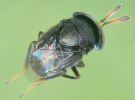
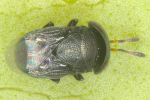 Adult female, dorsal view Adult female, dorsal view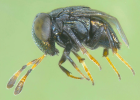
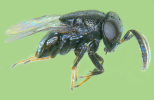 Adult female(left) and male(right) - lateral view Adult female(left) and male(right) - lateral view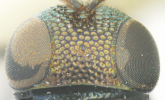 Head (Female) - frontal view
Head (Female) - frontal view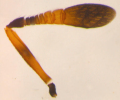
 Antenna - female Antenna - female
 Antenna - male Antenna - male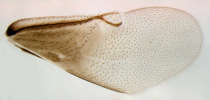
 Fore wing venation - female (left) and male (right)
Fore wing venation - female (left) and male (right)ImagesHosts / BiologyAppears to be specific to the solenopsis mealybug, Phenacoccus solenopsis Tinsley, which has become a serious invasive pest on several hosts like cotton, sunflower, tobacco, brinjal, etc. Hyperparasitoids including Prochiloneurus pulchellus Silvestri, P. albifuniculus (Hayat et al.), and P. aegyptiacus (Mercet) (Encyrtidae) and Promuscidea unfasciativentris Girault (Aphelinidae) have been recorded on this parasitoid, which may reduce its efficacy in the field.
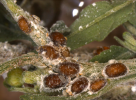
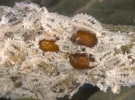
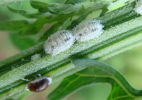 Cocoons of A. bambawalei in solenopsis mealybug colonies Cocoons of A. bambawalei in solenopsis mealybug colonies Promuscidea unfasciativentris Promuscidea unfasciativentris
References
|




